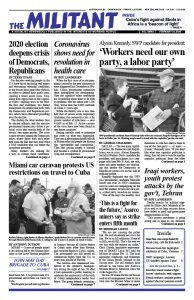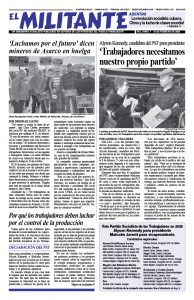When the first cases of acute pneumonia caused by the new coronavirus were diagnosed last December in Wuhan, China, government authorities there downplayed the development. Now the capitalist rulers worldwide are scrambling about what to do with an epidemic that has taken over 1,100 lives, worse than the SARS outbreak in China 17 years ago.
While the fatality rate is less than half that of severe acute respiratory syndrome, the coronavirus has a far greater number of infections — over 44,000 as of Feb. 12. Active carriers of the virus have now been found in two dozen countries.
Beijing initially tried to minimize and cover up what was happening. They sent a government health official to Wuhan who told people the disease was “preventable and controllable.” Then that person caught it himself and became a symbol of government lying and incompetence.
Provincial bureaucrats in Wuhan, unwilling to take decisive action without clear directives from Beijing, allowed the viral outbreak to spread.
Accepting Beijing’s initial reassurances that things were under control, officials of the World Health Organization waited a month before issuing an international health emergency alert Jan. 30. By then the virus had spread well beyond China.
Ignoring the mounting human toll, the capitalist business press in the U.S. and elsewhere focused their attention on the threat to stock market prices and trading profits.
One of the first individuals in China to sound the alarm was Dr. Li Wenliang. He raised with colleagues online seeing a strange new pneumonia-causing virus that required special precautions. Li was reprimanded by his hospital bosses and taken away by the police, who forced him and some others to sign confessions and pledge to stop spreading “rumors.” But it was the disease that was spreading.
When Li got the virus and died, it led to an explosion of anger and protests. Government censors were overwhelmed by online calls for freedom of speech and an end to state censorship.
As the scope of the disease became clearer, the Chinese rulers undertook a rapid and dramatic shift. An unprecedented quarantine lockdown was imposed on Wuhan and the surrounding Hubei province. The Lunar New Year holiday was extended and a large swathe of production and distribution in the world’s second largest economy was shut down.
The shutdown of much of China’s economy threatens to cut into global economic growth. Chinese tourism abroad has dried up and many Chinese students have been blocked from returning to educational institutions overseas. Many governments worldwide also imposed quarantine steps, such as cutting all travel links to China. The rulers in Russia and North Korea virtually shut down their borders with China.
Fighting disease a social question
This progression has stirred outrage and debate in China and across the world about how to deal with such major public health crises.
There is a shining example of what is possible — the volunteer “army of white coats,” in the words of Cuba’s communist leader, Fidel Castro, in October 2014 — the doctors and nurses who, with courage and discipline, extended their professional experience and working-class solidarity to successfully help lead the battle that eradicated Ebola in West Africa by mid-2015.
Because of the social conditions in Africa, a result of decades of oppressive colonial rule, that outbreak’s 28,652 cases resulted in some 11,325 deaths. The death rate in China today is far less.
This example of what human beings are capable of when science and culture are wielded by a revolutionary people in power is described in detail in Red Zone: Cuba and the Battle Against Ebola in West Africa.
A majority of the viral infections outside China have been among the 3,700 crew and passengers on the Diamond Princess cruise ship, forced to sit off the Japanese port of Yokohama. New cases keep extending the time those in contact with these individuals are being kept aboard. Those infected with the virus are rushed to specialized hospitals on shore, while the rest have to sit on the boat and wait their turn.
Another cruise ship — the Westerdam, with more than 2,000 aboard — is roaming the South China Sea with no government allowing it to dock, although there are no confirmed cases of the virus on board.
Most of the deaths have been in Wuhan, a port hub of 11 million people on the Yangtze River, and in that region. The quarantine zone around Wuhan was extended to encircle up to 60 million people. The lockdown in major cities, towns and villages confined many in their homes. They get by with food delivered by messengers who carry notes showing they don’t have a temperature.
Despite Beijing’s goal to become a technology superpower, there are less than two doctors for every 1,000 people in China. In the imperialist U.S. there are 2.6 per 1,000, largely deployed in the big cities. In sharp contrast, there are nine doctors per 1,000 in revolutionary Cuba, one of the highest ratios in the world.
Health system overwhelmed
“The hospital systems have been completely overwhelmed by the number of people who have been seeking care,” Gabriel Leung, dean of the medical school at the University of Hong Kong, told the Feb. 9 Financial Times, describing long lines and overcrowded emergency rooms in China.
In a widely publicized move, the Chinese government deployed soldiers, using resources from its state-linked construction companies, to build two new hospitals with some 2,600 beds in a couple weeks in Wuhan. But this is far from sufficient. “There are too many patients, far too many of them,” Wang Jing, a nurse at Wuhan Union Hospital West Campus, one of the facilities designated for coronavirus patients, told the Times. “And the demand for beds far outstrips supply.”
Concerned about the impact of the unprecedented shutdown of much of China’s already slowing capitalist economy, the state bureaucracy has shifted gears again. President Xi Jinping has reappeared — after virtually dropping out of sight for weeks — to warn top officials to refrain from “more restrictive measures” and to get the factories working again. And he ordered the state media to focus on “economic recovery.”
The Chinese Foreign Ministry appealed to foreign governments Feb. 11 to lift their travel restrictions, pleading this was needed for the health of the global economy (whatever it might mean to the health of the people). Worried about the combined health and economic crisis fueling domestic instability, the Chinese government now seeks to downplay the disease again and deflect blame from themselves by firing a range of provincial officials.

